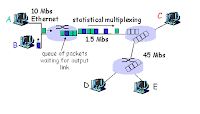A packet is a block of user data, together with a protocol header which includes address and administration information, to be delivered to the correct destination by the switches or routers in the network. A message may be broken down into multiple packets and each packet is transmitted individually and can even follow different routes to its final destination. Once all the packets forming a message arrive at the destination, they are recompiled into the original message. This process is known as Packet Switching.
Two basic approaches are common to Packet Switching:
- Virtual Circuit Packet Switching – An initial setup phase is used to set up a route between the intermediate nodes for all the packets passed during the session between the two end nodes. In each intermediate node, an entry is registered in a table to indicate the route for the connection that has been set up.
- Datagram Switching – This approach uses a different, more dynamic scheme to determine the route through the network links. Each packet is treated as an independent entity and its header contains full information about the destination of the packet. The intermediate nodes examine the header of the packet and decide to which node to send the packet so that it will reach its destination.
Circuit-switching is often compared with packet-switching. The main difference in Packet Switching from Circuit Switching is that the communication lines are not dedicated to passing messages from the source to the destination. Circuit Switching is ideal when data must be transmitted quickly, must arrive in sequencing order and at a constant arrival rate. Thus, when transmitting real time data, such as audio and video when quality of service (QOS) is highly desired, a Circuit Switched network is often used. Packet Switching is more efficient and robust for data that is bursty in its nature and can withstand delays and jitter in transmission, such as e-mail messages and Web pages.
Most data network protocols such as Wide Area Network (WAN) protocols, including TCP/IP, X.25, and Frame Relay, are based on packet-switching technologies. Notably, the Internet is a packet-switched network, running the Internet Protocol (IP) over a variety of other network technologies. Newer mobile phone technologies such as GPRS and i-mode also employ packet switching. In contrast, the traditional telephone service is based on a circuit-switching technology, in which a dedicated line is allocated for transmission between two parties. The Asynchronous Transfer Mode (ATM) attempts to combine the best of both worlds—the guaranteed delivery of circuit-switched networks and the robustness and efficiency of packet-switching networks.

No comments:
Post a Comment